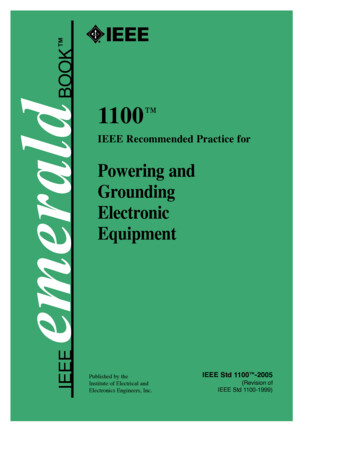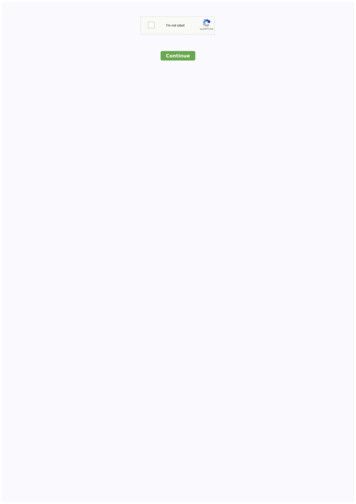
Transcription
1100 IEEE Recommended Practice forPowering andGroundingElectronicEquipmentPublished by theInstitute of Electrical andElectronics Engineers, Inc.IEEE Std 1100 -2005(Revision ofIEEE Std 1100-1999)
Recognized as anAmerican National Standard (ANSI)IEEE Std 1100 -2005(Revision ofIEEE Std 1100-1999)IEEE Recommended Practice forPowering and GroundingElectronic EquipmentSponsorPower Systems Engineering Committeeof theIndustrial and Commercial Power Systems Departmentof theIEEE Industry Applications SocietyApproved 9 December 2005IEEE-SA Standards BoardApproved 29 December 2005American National Standards Institute
Abstract: The IEEE Emerald Book presents a collection of consensus best practices for thepowering and grounding of electronic equipment used in commercial and industrial applications.The main objective is to provide consensus recommended practices in an area where conflictinginformation and conflicting design philosophies have dominated. The recommended practicesdescribed are intended to enhance equipment performance while maintaining a safe installation. Adescription of the nature and origin of power disturbances is provided, followed by theory on thevarious parameters that impact power quality. Information on quantifying and resolving power andgrounding related concerns using measurement and diagnostic instrumentation and standardizedinvestigative procedures are included. Recommended power protection equipment and wiring andgrounding system design practices are presented. Information on telecommunications systempower protection as well as grounding, industrial system grounding, and noise control is included.Finally a selection of case studies are presented to support the recommended practices presentedthroughout the book.Keywords: commercial applications, electrical power, electronic equipment, grounding, industrialapplications, power conditioning, power disturbance, power monitor, power qualityThe Institute of Electrical and Electronics Engineers, Inc.3 Park Avenue, New York, NY 10016-5997, USACopyright 2006 by the Institute of Electrical and Electronics Engineers, Inc.All rights reserved. Published 24 May 2006. Printed in the United States of America.IEEE is a registered trademark in the U.S. Patent & Trademark Office, owned by the Institute of Electrical and ElectronicsEngineers, Incorporated.National Electrical Code and NEC are both registered trademarks of the National Fire Protection Association, Inc.National Electrical Safety Code and NESC are both registered trademarks and service marks of the Institute of Electricaland Electronics Engineers, Inc.NEBS is a trademark of Telcordia Technologies, Inc.Telcordia is a registered trademark of Telcordia Technologies, Inc.Print:PDF:ISBN 0-7381-4979-9 SH95510ISBN 0-7381-4978-0 SS95510No part of this publication may be reproduced in any form, in an electronic retrieval system or otherwise, without the priorwritten permission of the publisher.
Grateful acknowledgment is made to the following for having granted permission to reprint illustrations in thisdocument, as follows:American Power Conversion (APC) for Figure 9-14.BICSI for Figure 9-12, 9-13, and 9-15.Bourns, Inc., “Selection Guide, Telecom Circuit Protection,” 2000, for Figures 9J-1, 9J-2, and 9J-3; “TelecomCircuit Protection Trends,” M. J. Maytum, Power Innovations Limited, Passive Component Industry, January/February 2001, vol. 3, no. 1, for Figures 9J-1, 9J-2, 9J-3, 9J-4, 9J-5, 9J-5, 9J-6, and 9J-7. Figures 9J-1 and9J-2 also appear in IEC 61643-22, edition 1.0, 2004-11.Cooper Bussmann, Inc., for Figures 9-33 and 9-34.Emerson Network Power, “Emerson’s 2004 Power Seminar Presentations,” for Figures 9-26, 9-27, 9-29, 9-30,9-31, 9D-2, and 9D-8.EnerNex Corporation for Figure 8-5.EPRI Solutions Inc.EquiTech Corporation for Figures 9-75 and 9F-5.EYP Mission Critical Facilities, Inc., for Figures 4-1, 4-2, 4-3- 4-4, 4-23, 4-24, 4-25, 4-26, 4-28, 4-29, 4-30,4-31, 4-34, 4-35, 4-36, 4-37, 4-48- 4-49, 4-50, 4-53, 4-54, and 4-71.Liebert Corporation for Figures 7-6, 7-7, 7-8, 7-9, 7-10, 7-11, 7-13, 7-16, 7-17, 7-19, 7-20, 7-21, 7-22, 7-24,7-25, 7-26, 7-27, 7-28, 7-29, 7-30, 7-31, 9-21, 9-22, 9-24, 9H-1, and 9H-2.D. R. MacGorman, M. W. Maier, and W. D. Rust, “Lightning Strike Density for the Contiguous United Statesfrom Thunderstorm Duration Records,” for Figure 3-3.A. McEachern, Handbook of Power Signatures, for Figure 4-42.National Electrical Manufacturers Association for Table 4-1.Nortel Networks (with clarity edit made by William Bush, SPGS, Inc.) for Figure 9-59.Protection Technologies, Inc., for Figures 9F-1 and 9F-2.Rockwell Automation, Inc., for Figures 9-13 and 9-15.Schneider Electric SA/Square D for Figures 10-1, 10-2, 10-3, 10-4, 10-8, 10-17, 10-18, 10-19, 10-20, and10-21; Table 10-1.SEMI (Semiconductor Equipment and Materials International, Inc.), SEMI F47-0200, “Specification forSemiconductor Processing Equipment Voltage Sag Immunity,” February 2000, for Figure 3-13.Signals, Power & Grounding Specialists, Inc. (SPGS).Skyline Marketing Group for Figures 9D-3, 9D-4, 9D-5, and 9D-6.Ronald B. Standler, Protection of Electronic Circuits from Overvoltages, for Figure 4-14.The Dranetz Field Handbook for Power Quality Analysis for Figures 2-1, 4-40, 4-41, A-1, A-2, and A-3.Vaisala Inc. for Figure 3-4.
IEEE Standards documents are developed within the IEEE Societies and the Standards CoordinatingCommittees of the IEEE Standards Association (IEEE-SA) Standards Board. The IEEE develops its standardsthrough a consensus development process, approved by the American National Standards Institute, which bringstogether volunteers representing varied viewpoints and interests to achieve the final product. Volunteers are notnecessarily members of the Institute and serve without compensation. While the IEEE administers the processand establishes rules to promote fairness in the consensus development process, the IEEE does not independentlyevaluate, test, or verify the accuracy of any of the information contained in its standards.Use of an IEEE Standard is wholly voluntary. The IEEE disclaims liability for any personal injury, property orother damage, of any nature whatsoever, whether special, indirect, consequential, or compensatory, directly orindirectly resulting from the publication, use of, or reliance upon this, or any other IEEE Standard document.The IEEE does not warrant or represent the accuracy or content of the material contained herein, and expresslydisclaims any express or implied warranty, including any implied warranty of merchantability or fitness for a specific purpose, or that the use of the material contained herein is free from patent infringement. IEEE Standardsdocuments are supplied “AS IS.”The existence of an IEEE Standard does not imply that there are no other ways to produce, test, measure,purchase, market, or provide other goods and services related to the scope of the IEEE Standard. Furthermore, theviewpoint expressed at the time a standard is approved and issued is subject to change brought about throughdevelopments in the state of the art and comments received from users of the standard. Every IEEE Standard issubjected to review at least every five years for revision or reaffirmation. When a document is more than fiveyears old and has not been reaffirmed, it is reasonable to conclude that its contents, although still of some value,do not wholly reflect the present state of the art. Users are cautioned to check to determine that they have thelatest edition of any IEEE Standard.In publishing and making this document available, the IEEE is not suggesting or rendering professional or otherservices for, or on behalf of, any person or entity. Nor is the IEEE undertaking to perform any duty owed by anyother person or entity to another. Any person utilizing this, and any other IEEE Standards document, should relyupon the advice of a competent professional in determining the exercise of reasonable care in any given circumstances.Interpretations: Occasionally questions may arise regarding the meaning of portions of standards as they relate tospecific applications. When the need for interpretations is brought to the attention of IEEE, the Institute will initiateaction to prepare appropriate responses. Since IEEE Standards represent a consensus of concerned interests, it isimportant to ensure that any interpretation has also received the concurrence of a balance of interests. For this reason, IEEE and the members of its societies and Standards Coordinating Committees are not able to provide an instant response to interpretation requests except in those cases where the matter has previously received formalconsideration. At lectures, symposia, seminars, or educational courses, an individual presenting information onIEEE standards shall make it clear that his or her views should be considered the personal views of that individualrather than the formal position, explanation, or interpretation of the IEEE.Comments for revision of IEEE Standards are welcome from any interested party, regardless of membershipaffiliation with IEEE. Suggestions for changes in documents should be in the form of a proposed change of text,together with appropriate supporting comments. Comments on standards and requests for interpretations shouldbe addressed to:Secretary, IEEE-SA Standards Board445 Hoes LanePiscataway, NJ 08854USANOTE Attention is called to the possibility that implementation of this standard may require use ofsubject matter covered by patent rights. By publication of this standard, no position is taken withrespect to the existence or validity of any patent rights in connection therewith. The IEEE shall not beresponsible for identifying patents for which a license may be required by an IEEE standard or forconducting inquiries into the legal validity or scope of those patents that are brought to its attention.Authorization to photocopy portions of any individual standard for internal or personal use is granted by the Institute of Electrical and Electronics Engineers, Inc., provided that the appropriate fee is paid to Copyright ClearanceCenter. To arrange for payment of licensing fee, please contact Copyright Clearance Center, Customer Service,222 Rosewood Drive, Danvers, MA 01923 USA; 1 978 750 8400. Permission to photocopy portions of anyindividual standard for educational classroom use can also be obtained through the Copyright Clearance Center.
Introduction(This introduction is not part of IEEE Std 1100-2005, IEEE Recommended Practice for Powering and GroundingElectronic Equipment.)This recommended practice is a publication of the Industry Applications Society (IAS) of the IEEE and isone of the IEEE Color Books , which relate to industrial and commercial power systems. The recommendedpractices described are intended to enhance equipment performance from an electric powering andgrounding standpoint, while maintaining a safe installation as prescribed by national and local electric coderequirements. The purpose of this recommended practice is to provide consensus recommended practices inan area where conflicting information and conflicting design philosophies have dominated.As the proliferation of digital electronic equipment continues to change the way society utilizes and relies onelectric power continuity, the need for standardized practices for power protection and grounding continuesto grow. The requirements of the digital society have essentially outgrown the capabilities of the present dayelectric power supply, and the need for practices that promote system compatibility of both the electricsupply and the connected equipment is important from the largest industrial facilities all the way down tohome offices. The concept of system compatibility, which is covered extensively in this book, describes themechanisms of interaction and requirements necessary to ensure that not only does the electrical powerequipment connected to its power source operate properly even during moderate power fluctuations, but alsothat same equipment does not interfere with other equipment connected to the common power system. Theresponsibility for system compatibility is shared among all parties, including the electric suppliers, theequipment manufacturers, the building designers, the power conditioning equipment manufacturers, and thefacility equipment specifiers, and this document supplies methods to ensure that when a systemcompatibility problem is present, there are adequate means of investigating and resolving the concern. It isalso the intent of this document to supply power system design guidelines and recommended practices thatwould minimize the potential for a system compatibility concern to occur.To address the topics detailed in the IEEE Emerald Book , the IEEE Working Group on Powering andGrounding Electronic Equipment was originally formed in 1986 to write a recommended practice. The firstIEEE Emerald Book was subsequently published in 1992, followed by a revision in 1999. The project wassponsored by the IAS Industrial and Commercial Power Systems Engineering Subcommittee. Thisrecommended practice is intended to complement other recommended practices in the IEEE Color Books and has been coordinated with other related codes and standards.Notice to usersErrataErrata, if any, for this and all other standards can be accessed at the following URL: ata/index.html. Users are encouraged to check this URL forerrata periodically.InterpretationsCurrent interpretations can be accessed at the following URL: x.html.Copyright 2006 IEEE. All rights reserved.v
PatentsAttention is called to the possibility that implementation of this standard may require use of subject mattercovered by patent rights. By publication of this standard, no position is taken with respect to the existence orvalidity of any patent rights in connection ther
IEEE Emerald Book presents a collection of consensus best practices for the powering and grounding of electronic equipment used in commercial and industrial applications. The main objective is to provide consensus recommended practices in an area where conflicting information and conflicting design philosophies have dominated. The recommended practices described are intended to enhance .
